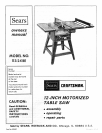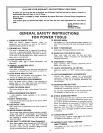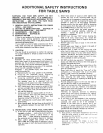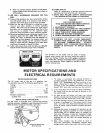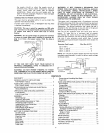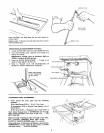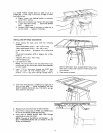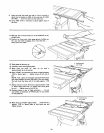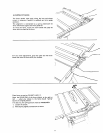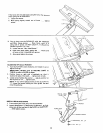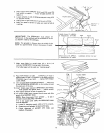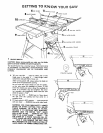
B. Never use grinding wheels, abrasive cut-off wheels,
friction wheels (metal slitting blades) wire wheels or
buffing wheels.
11. USE ONLY ACCESSORIES DESIGNED FOR THIS
SAW.
12. Cross-cutting operations are more conveniently worked
and with greater safety if an auxiliary wood facing is
attached to the miter gaugeusingthe holes provided.
13. Make sure the top of the arbor or cutting tool rotates
toward you when standing in normal operating
position. Also make sure the cutting tool, arbor collars
and arbor nut are installed properly. Keep the cutting
tool as low as possible for the operation being
performed. Keep all guards in place whenever possible.
14. Do not useany blade orother cutting tool marked for an
operating speed less than 3450 RPM. Never use a
cutting tool larger in diameter than the diameter for
which the saw was designed. For greatest safety and
efficiency when ripping, use the maximum diameter
blade for which the saw isdesigned, since under these
conditions the spreaderis nearestthe blade.
15, Adjust table insertsflush with the table top. NEVER
operate the saw unlessthe proper insert isinstalled.
WEAR YOUR
16. THINK SAFETY.
Safety is a combination of operator common senseand
alertnessat all times when the saw isbeing used.
17. NOTE AND FOLLOW SAFETY INSTRUCTIONS
THAT APPEAR ON THE FRONT OF YOUR SAW.
DANGER
FOR YOUR OWN SAFETY
READ AND UNDERSTAND OWNER'S MANUAL
BEFORE OPERATING MACHINE:
1. WEAR SAFETY GOGGLES
2. USE SAW-BLADE GUARD FOR "'THRU-SAWlNG"
3. KEEP HAMDS OUT OF PATH OF SAWBLADE
4. USE A"PUSH-STICK" WHEN REQUIRED
5. KNOW HOW TO AVOID "KICKBACKS'"
6. DO NOT PERFORM OPERATIONS "FREEHAND"
18. WARNING: DO NOT ALLOW FAMILIARITY
(GAINED FROM FREQUENT USE OF YOUR SAW)
TO BECOME COMMONPLACE. ALWAYS
REMEMBER THAT A CARELESS FRACTION OF A
SECOND IS SUFFICIENT TO INFLICT SEVERE
INJURY.
The operation of any power tool can result in foreign
objects being thrown into the eyes, which can result in
severe eye damage. Always wear safety gogglescomplying
with ANSI Z87.1 (shown on Package) before commencing
power tool operation. Safety Goggles are available at Sears
retail or catalog stores.
MOTOR SPEC|FICATIONS AND
ELECTRICAL REQUIREMENTS
MOTOR SPECIFICATIONS
The AC motor used in this saw is a capacitor start,
non-reversible type, with the following specifications:
Voltage ................................. 240
Amperes .................................. 7
Hertz ................................... 60
Phase ................................ Single
RPM .................................. 3450
Rotation (viewed from
sawblade end) ............... Countemlockwise
MOTOR SAFETY PROTECTION
The saw motor is equipped with a manual-reset thermal
overload protector, designedto open the power line circuit
when the motor temperature exceeds asafe value.
OVERLOAD PROTECTOR
(RED BUTTON)
I. "If motor is overloaded and overload protector is
actuated (stopping motor) BE POSITIVE you push
switch "'OFF" immediately and allow the motor to cool
before attempting to reset the protector. Since the
protector is near _he sawblade, the switch must not be
turned "ON" until after you have reset the protector.
2. If the red button will not snap into place immediately,
the motor is still too hot and must be allowed to cool
for a while longer.
3. As soon as the red button will snap into running
position, the saw may be started and operated normally
by moving the saw switch lever to the "'ON" position.
4. Frequent opening of fuses or circuit breakers may result
if motor is overloaded, or if the motor circuit is fused
with a fuse other than those recommended. Do not use
a fuse of greater capacity without consulting the power
company.
5. Although the motor is designed for operation on the
voltage and frequency specified on motor nameplate,
normal loads will be handled safely on voltages not
more than 10% above or below the nameplate voltage.
Heavy loads, however, require that voltage at motor
terminals be not less than the voltage specified on
nameplate.
6. Most motor troubles may be traced to loose or
incorrect connections, overloading, reduced input
voltage (which results when small size wires are used in



